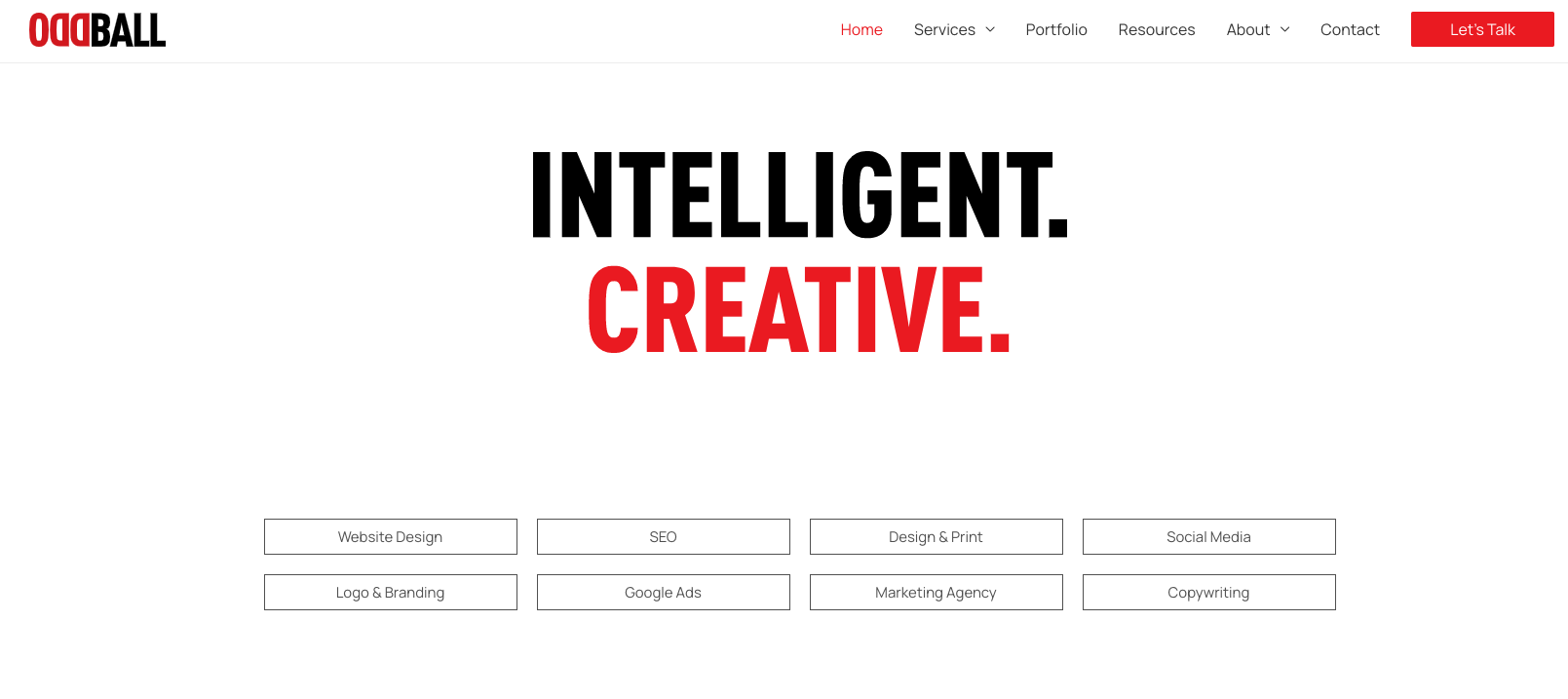The time it takes for your website’s visitors to decide whether to go to a competitor’s site is less than 10 seconds. So, you have to make every second count.
Redesigning a website involves significantly changing various elements of your present site, such as its code, content, structure, and visual appeal.
So why would you consider tinkering with something if there’s a risk of losing traffic and potential customers to your website?
The answer is simple: your customers notice, engage with and value any positive changes you make to provide greater flexibility, as well as a faster and more user-friendly service.
If your site has had the same look and functionality for years, your visitors are more likely to be attracted to your competitor sites, which are probably newer and already taking advantage of fresh technologies and plug-ins.
A website redesign shows your customers you move with the times, that you adapt to meet their needs and provide them with more ways to interact with your products and services.
Oddball is no stranger to this redesign process, having undertaken this task numerous times throughout our history. Here’s a side-by-side of our most recent revamp.


In many cases, businesses are forced to redesign due to reasons we will explore further below. The important thing is your site needs to function right, every time.
This website redesign guide is all you need to: understand what’s involved in the process; learn why a revamp is generally good for business; and map out the necessary steps you need to take to ensure a successful redesign and maintain your competitive edge.
Why Redesign A Website?
There are many benefits to redesigning a website.
You might want to add new products and services, upgrade your Content Management System (CMS), fix up an outdated or unprofessional-looking design, or take advantage of new technologies to meet mobile web requirements.
You will most likely need a website redesign if:
- There’s a change in your service and product
- There’s a change in your brand strategy
- There’s an ecommerce development, or web tech upgrade
- Your site has a poor website conversion rate
- Your web pages are not being indexed by search engines properly
- There is an organisational restructure
A successful website redesign boosts revenue, lowers bounce rates, and improves user experience (UX). A revamp is so important for the continued success of your business.
How Often Should A Website Be Revamped?
The industry standard is to update your website every 2-3 years.
This does not include the content of course – such as blogs and landing pages – which should be updated as regularly as possible.
However, since customer preferences, browser technologies, and accessibility standards are always changing, there is no definitive timeframe for when you should redesign your website.

By monitoring the state of your website and your goals, you can identify new opportunities for improving conversion rates (CRO) and user experience (UX) through a redesign.
Smaller redesigns – or refreshes – are not usually wholesale changes, but are more often just minor design tweaks to keep the website looking fresh and fit-for-purpose.
A more custom, robust website redesign can help make it last for much longer if the key elements of the business remain the same.
Website Redesign vs Website Refresh
This all depends on how many changes you’re making during the process, and how far-reaching they are:
When a website is redesigned, the code and appearance are usually significantly altered. For example, the new visual identity, branding, and information architecture are all introduced at the same time, as well as potentially a new CMS.
If minor changes are made to the site’s functionality and structure, it is considered to have been refreshed. An example would be an update to the colour palette and typography of the site, or changes to the layout of individual pages.
Although a redesign and a refresh have different demands on resources, they both have one fundamental characteristic in common: both will affect your customers in some way.
Whether it’s a redesign or a refresh, it’s less important than how you choose to go about it.
A Good Redesign Strategy
Never redesign for the sake of it. Have a clear strategy in place, and avoid these common website mistakes where possible.
This is a sensible 10-step guide to mapping out your website revamp project.
1. Look at what is working for you on your existing site (keep the good stuff)
Use Google Analytics to understand where your customers visit and how they navigate around your website.
You want to understand this customer journey and keep what is working for you – or at least the essence of what is making this successful for you.
These pathways will form the bones of your site around which your redesign will be shaped.
Too often, businesses do a redesign of their website and ignore this or start from scratch in the transition, which can only alienate existing customers for the sake of attracting new ones.
2. Figure out what’s missing and what you need on your site (fill the gaps)
This is where it comes down to really knowing who your customer is.
Remember, a redesign is not for you, it’s for your customers.

How well do you know them? How will your redesign better serve their needs?
As you begin to redesign your site, keep everything that works and add in new features that improve your customers’ experience.
3. Understand and explain what you hope to achieve with your site revamp (set goals)
Are you looking for more traffic, more sales, both? Do you want to build your brand and increase your online footprint with more products and services?
Are you adding an online shopping section?
Sort these questions out early, before you even begin to map out a revamp strategy.
Always keep your customer at the forefront of everything, but set some achievable objectives around the purpose of your redesign.
Get started by defining what you want to achieve in the next 1 and 3 years, and how you’ll measure your success. Be as specific as you can – if you don’t know where you’re going, how will you know when you get there!
So for example: “Get more customers” or “More profit” won’t cut it. A large aspect of marketing is numbers and analytics, so in order to be successful you must make it as quantifiable as possible.
E.g. “Increase customer base by 50%” or “Increase profit margin to 45%” will work much better. That way you can set your individual marketing KPIs according to these numbers.
Here are 7 crucial steps to a killer marketing plan.
4. Get your new branding and messaging right BEFORE you map out the redesign
Sometimes it makes sense to change your logo and branding along with a website redesign for maximum impact. But not always.
Be guided by marketing experts on the value of making wholesale changes to your branding, but certainly consider how your messaging needs to change.
A new site indicates a change to the customer experience, so you need to fully prepare them and explain the reason behind any changes.
This is best achieved both prior to any changes being made and directly after a revamp.
5. Ensure you don’t lose traffic by protecting your existing SEO pages and rankings
You never want to lose all the hard work you’ve put into building up a strong search ranking.
Here’s a simple SEO website redesign checklist to help you keep all that SEO goodness for your new website:
- Index any new pages and links.
- Implement 301 redirects from old links to new links.
- Prioritise pages and update URLs on the new website.
- Submit an XML sitemap to the search console.
- Check for crawl rate errors in the search console.
- Backup everything
6. Do an audit of competitor sites: see what they’re doing well/exploit gaps
Study your competitor’s website and note what you like and dislike.
By finding out what your website can do better, you can improve upon it.
Identify some areas for improvement and ways you can differentiate yourself from your competitors once you have conducted your competitive analysis.
7. Do an audit of what your best-performing assets are and look to leverage these
Your existing website likely contains many high-performing content assets that you’ve already built up, and losing their effectiveness because of a redesign can severely damage your marketing results.
Your most popular or viewed content, high-traffic pages, best performing and ranking keywords and associated pages, and links to individual pages are some key examples.
Moreover, by culling a page with many inbound links from your site, you may lose a lot of SEO credit, thus making it harder to get found on search engine results pages (SERPs).
Many designers aren’t even aware of this step because they’re not marketers or SEO specialists. That’s why a marketing agency is always a safer bet for a redesign.
8. Draft up some wireframes and get your website architecture in place
Content planning and sitemap planning are both aspects of website architecture.
Search engines can better crawl links, pages, and content on websites when they are laid out in a hierarchical manner, complete with categories and links.
9. Choose the right agency, designer or software for your redesign
There are hundreds of content management systems available.
Our CMS of choice is WordPress for its ease-of-use, functionality and adaptability.
While templates exist to get you started straight away, it’s a different challenge moving an existing website over to WordPress.
Oddball Marketing is adept at porting online businesses over to WordPress and can also redesign websites using other CMS platforms, should you wish to continue using your existing CMS.
10. Stress-test and troubleshoot as much as possible before launch
Re-test and re-evaluate both before and after launch.
After your redesign is complete, you should always continue to test and implement changes.
That’s why post-launch training for your staff is so important, as well as having professional back-end, security and hosting support when needed.
It doesn’t end there. Explore these marketing strategies to further promote your redesign.

Ecommerce Website Redesign
A modern ecommerce site has to be designed for mobile first. If it’s not, a redesign is vital.
Mobile accounts for approximately half of web traffic worldwide. In the first quarter of 2021, mobile devices (excluding tablets) generated 54.8% of global website traffic, consistently hovering around the 50% mark since the beginning of 2017. (Source: Statistia)
You don’t need loads of bells and whistles on your ecommerce site – all they do is distract attention. Keep your redesign clear, clean, and simple – and maintain the focus on the sale.
Also, payment wallet services such as PayPal, Apple Pay and Android Pay are on the rise.
When we can enter a password, fingerprint, or face scan instead of filling out a form to proceed directly to checkout, it is much more convenient.
Ecommerce is mobile-driven, so easy, form-free payment methods are essential.
Have a look at Google Analytics. A bounce rate for ecommerce sites ranging from 26-40% is great, 41-55 is about average, and anything between 56-70 is not great.
The important elements of redesigning an ecommerce website are:
- Keep it simple. Use clear, easy navigation.
- Make the checkout process seamless, or at least easy.
- Include search or filter features where possible.
- Use clear calls-to-action (CTAs)
A Word On Integrations
Today’s websites require external software or services to provide functionality.
Integrations play directly into the turnaround time for a website redesign project.
You should consider how your website might integrate with other systems to fulfill its function. Perhaps you are already using them, or maybe you haven’t been able to accommodate them yet.
Consider the following integration points:
- Customer Relationship Management (CRM) systems, like Salesforce, ActiveCampaign, or Microsoft Dynamics
- Email marketing platforms, like Mailchimp, HubSpot, or Constant Contact
- Google Analytics or other tools for data collection/analysis
- ERP systems, like SAP, Sage, or NetSuite
- Internal or external APIs that provide data or resources
- Other custom business applications for business workflows or processes
What The Website Redesign Process Looks Like
Not all website redesign processes are the same, but they usually follow these six stages:
| Discovery | Design | Content |
| Create strategies, sitemaps, numbers of pages, how these pages are related, and which ones will have custom designs | Mocking up draft versions. This could be customised for individual pages, or a template for multiple pages | Reviewing existing content and creating new content where there are gaps |
| Development | Review | Launch |
| The structure of your website is built from approved designs, with the functionality you need | The website goes through an approval process, where feedback and changes are made and approved | Once the site is approved, any necessary content migration is performed and the new website goes live |
Each stage has its own challenges and timelines, but all are necessary touchpoints along the way to a successful website revamp.

Your 9-Point Redesign Checklist
- If you can, discuss your redesign with a marketing agency or website designer first before trying to do it all yourself – it can be a massive time sink for the uninitiated, and may end up costing you more in missed opportunities over time.
- Slow down! Website redesigns don’t happen overnight. There is a lot of careful planning that goes into them. Take your time at the start to map things out, identify the obstacles, and aim to rebuild in phases rather than all at once.
- Set some goals. Reassess how you are using Google Analytics. Work out how many total leads you hope to gain each month after the redesign.
- Know your users. Identify your ideal target audience by conducting a thorough market analysis. This will determine which groups are most valuable, develop precise buyer personas and build a more specific marketing strategy for your business.
- Know your competitors. Find 3-5 examples of websites you like. Do what they do, but do it better and differentiate in a smarter way.
- Get the design and development team together. Name a single person at your company to be the point of contact with your developer. Meet the team and have 1-2 discovery meetings before any work begins.
- Don’t forget your SEO.
- Develop a content strategy. Think about possible content pieces for lead magnet items. Decide who will write your blogs and what they will be about.
- After launch, be prepared for the unexpected. It is important that your website is regularly updated and evolving. Tidy up any errors, do speed tests and work on making the customer experience smoother and faster.
- Download a free copy of our Oddball Marketing Game Plan here. (PDF)
Website redesign isn’t just about changing the look. You do it to add missing functionality, improve the design, restructure the information architecture, and remove unnecessary components that confuse the user interface and make your site difficult to use.
Oddball Marketing’s website redesign services are done wholly in-house, and use the skills and expertise of our full team of marketing experts. We can help you to refresh your website to achieve your business goals, boost your brand image, traffic, leads and sales. Contact us today to see how we can help revamp your website.
Website Redesign FAQs
- How does the revamp process work?
A typical website redesign process may involve audit request, needs assessment, project agreement, web redesign planning and mock-ups approval, development, launch phase, and post launch phase of the website redesign project.
- How much does a redesign cost?
Websites are so different, so the cost of a website redesign varies. It depends on the size of the existing website, the amount of content required for the revamp, whether the branding will change – it all comes down to the planning and work required.
- Why do some website redesigns fail?
Design is only one piece of the puzzle. If you put too much emphasis on this element and neglect the performance of your new-look website, you will always have problems. Similarly, if you don’t have a good strategy in place from the start and stick to it, your redesign will struggle. What usually happens then is businesses go over budget making constant tweaks to fix previously avoidable issues.
- How long does it take to do a website redesign?
Because every website is unique, every redesign is greatly impacted by what you want to gain from the finished product. Do you need a template-based website? How about a fully customised e-commerce website? Even simple answers to these questions can drastically change how long a redesign takes.
To keep your timeline and budget on track, follow these tips:
- Understand the needs and goals for your website
- You should be able to make quick and clear decisions that you can stick to
- As much as possible, avoid pivoting and scope changes






